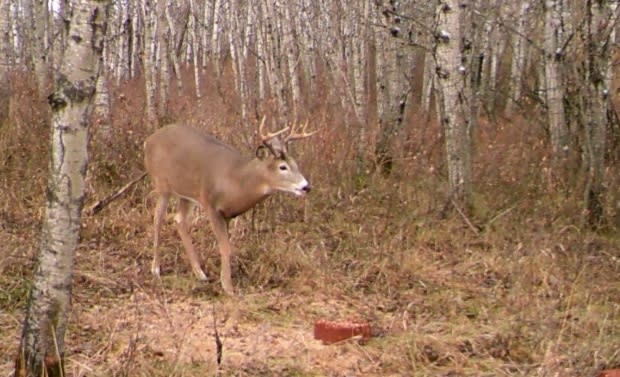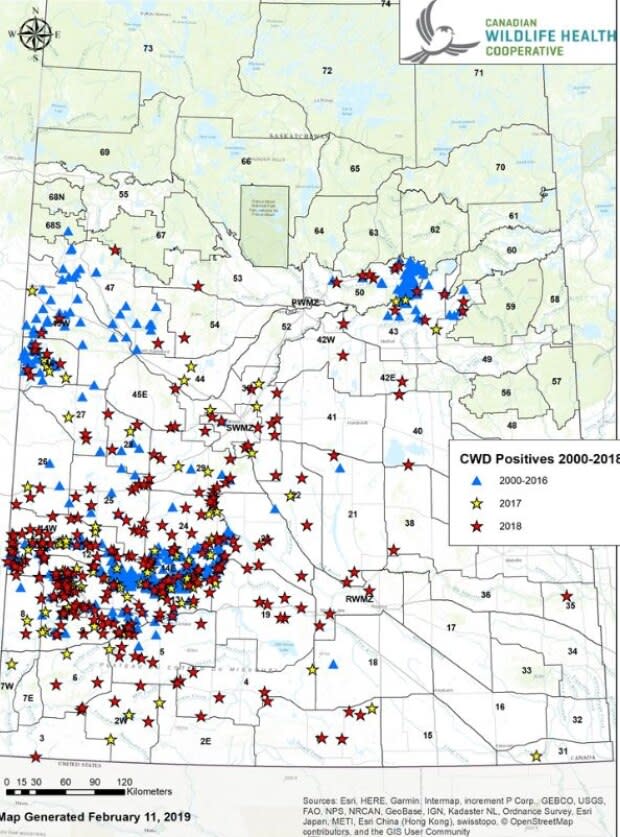'It's a no-brainer': Hunters call for steps to stop 'Zombie deer disease' epidemic
Deer hunter David Pezderic used to lay out hay or grain as bait to lure white-tailed deer near his farm in the Saskatoon area.
But that was 15 years ago. Pezderic stopped the controversial hunting practice after deciding it was not only unethical, but dangerous.
Baiting encourages deer to congregate in unnatural ways, increasing the likelihood they'll transmit the highly contagious chronic wasting disease (CWD) through exposure to infected feces, urine, and saliva. The neurological disease eats holes in the brains of deer, elk, and moose, causing them to stumble, drool, and generally act like zombies before dying.
The Saskatchewan Wildlife Federation (SWF) is calling for mandatory testing of all cervid (member of the deer family) carcasses in CWD surveillance zones and a ban on bait use by all hunters and game farms.
"We think it should simply cease and desist in the province of Saskatchewan," Pezderic, an SWF board member, said on behalf of the conservation and hunting group's 36,000 members.

CWD has been detected in some wild deer in three quarters of the province of Saskatchewan.
There is no direct scientific evidence that CWD can be transmitted to humans, but the Canadian Food Inspection Agency and World Health Organization say people should not consume contaminated animals.
The SWF, along with nearly three dozen doctors, researchers and advocates, sent a letter to the federal government to take urgent action to limit the spread of what they describe as an epidemic.
The Canadian Food Inspection Agency is tasked with keeping contaminated meat out of the commercial meat market, but provinces handle regulations that would address private consumption of hunted meat.
17% of tested deer in Saskatchewan have contagious disease

In 2018, hunters harvested 34,930 white-tailed and mule deer in Saskatchewan, according to government records. Of those, only a small fraction of heads were submitted for testing — 2,000 samples or roughly six per cent.
Of those, about 17 percent of the submitted samples tested positive for CWD, triggering alarm among those who worry about people eating contaminated meat.
I wouldn't jump to the conclusion that people are likely eating CWD-infected meat. - Kevin Murphy, Saskatchewan's associate deputy minister of Environment
Pezderic waited for a negative test result on his whitetail last year before personally butchering the animal and filling his freezer with deer steak, roasts, and ground meat. He said he believes some hunters who didn't submit their samples have been unwittingly sharing and eating contaminated meat.
Kevin Murphy is Saskatchewan's assistant deputy environment minister, in charge of resource management and compliance.
"I wouldn't jump to the conclusion that people are likely eating CWD-infected meat," Murphy said. "It's a possibility, but I wouldn't conclude that that's actually occurring right now."
Murphy said people should know the disease exists and that they can submit samples for testing.
It's illegal to use baits in Alberta and Manitoba
Murphy says Saskatchewan has no plans to ban baits. It's illegal in both Alberta and Manitoba, with some exceptions for bears and wolves.
Manitoba initially banned the use of baits for hunting cervids more than 40 years ago because the government determined it was "an unfair hunting practice," according to a provincial spokesperson. About 15 years ago, it further banned anyone from feeding deer along the Saskatchewan border to strengthen its defence against CWD.
Alberta Environment and Parks introduced its ban in 1989, before CWD arrived in Canada. Today, a ministry spokesperson said the ban helps stop disease transmission.
CWD continues to spread among Alberta's cervid population. The province tested 7,866 heads last year, and detected CWD in 579, or 7.4 per cent, of samples. Most infected animals were located along the Alberta-Saskatchewan border.
Saskatchewan government prefers regulations, not a ban
"Baiting has not been seen as an unfair hunting practise [in Saskatchewan]," Murphy said.
To combat CWD, he prefers regulations over an outright ban.
"We do have regulations in place for where baits can be placed, what baits can be placed, and for how long," Murphy said, adding that the government is working with outfitters to beef up professional standards.
Hunting outfitters and game farms are big business in Saskatchewan, often catering to American hunters, and baits help guarantee customer satisfaction.
"If you can make some significant changes to the way the bait's being introduced, and limit that congregation, it's still an opportunity for industries, like outfitters, to continue to use the practise, while dramatically decreasing the risk," Murphy said, adding that he's not aware of research proving a ban would eliminate CWD.
"It's a no-brainer," Darrel Rowledge, an Alberta hunter and the director of Alliance for Public Wildlife, said. "Nobody ever claimed that it would eliminate anything, but that doesn't mean that [baiting] isn't making things dramatically worse."
Calls for mandatory testing
In parts of B.C., Alberta and Manitoba, hunters have no choice but to submit carcass samples for CWD testing.
"We ought to make it mandatory with some penalties if if we don't comply," Pezderic said. "It's the only way to protect the public and the only way to protect our wildlife populations long term."

The Environment Ministry says it will consider mandatory testing in some areas of Saskatchewan, but will put more focus on raising awareness among hunters and making testing more accessible with a faster turnaround of results.
Currently, hunters in rural and remote parts of the province have limited options for drop off points with freezers and it can take awhile for someone to pick up the frozen samples for transport to the Saskatoon lab that tests them. After lab workers have thawed a deer head, the test itself takes 7 to 10 days.
The influx of samples at the end of hunting season means some hunters can wait months for results.
Murphy says the Environment Ministry is planning to add more drop-off points and speed up its collection program. It's working with the ministries of agriculture and health on a provincial CWD response.
"We're doing what we think is both practical and possible," Murphy said.
Indigenous hunters consume meat quickly
In Indigenous communities, hunters that return with deer or elk quickly distribute the meat to their families and community members. In some cases, a hunting group is deployed to provide fresh meat for a community event.
In an Indigenous community, even a two-week wait for CWD test results is "eons to have a perfectly good deer sitting around," says Kevin McLeod, director of environmental health for the Federation of Sovereign Indigenous Nations.

McLeod said he wants to see more resources to track the progress of the disease and limit its spread into the north and to vulnerable caribou populations. He also called for faster testing so Indigenous communities don't consume contaminated meat.
"There's a risk in saying, 'there's no risk,' " McLeod said.
He said health agencies forbidding contaminated meat from entering the commercial meat market is proof that they should also step up efforts to stop contaminated meat from being consumed at the community level.


